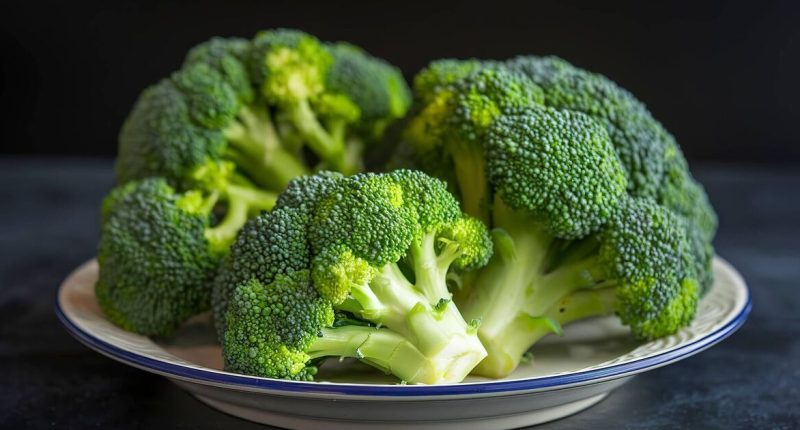Share this @internewscast.com

Stop boiling your broccoli — the microwave is healthier (Image: Getty)
Love it or loathe it, it pays to eat your broccoli. Packed with vitamins C, K, and A, this veggie boasts anti-inflammatory properties, cholesterol-lowering abilities and is loaded with sulforaphane — a powerful nutrient and antioxidant that could reduce the risk of cancer.
It so happens that sulforaphane is one of broccoli’s main chemicals. Brussels sprouts, cauliflower and kale also contain the suphur-rich compound that makes the veg bitter. Surprisingly, Professor Tim Spector suggested that microwaving can amplify broccoli’s health benefits, on a recent episode of the ZOE Science and Nutrition podcast.
Read more Dolly Parton’s 15-minute broccoli salad includes 1 unusual ingredient

Brussels sprouts and kale also have the powerful nutrient (Image: Getty)
How to cook broccoli and make it even healthier
1. The chop and stop technique
Enhancing the nutritional yield from broccoli begins before it even hits the heat. Prof Spector endorses a prep method known as “chop and stop,” applicable to not just broccoli but garlic and onions too, reports Surrey Live.
“Now, there are some problems with sulforaphane, because if you just throw your broccoli into a pan, you’ll actually inhibit the sulforaphane from being released because the heat does this. So there’s a little chemistry that needs to be going on here.”
To bypass this issue, he advises: “So I’ve got a tip to overcome this, something called chop and stop. This is the same for broccoli, and it’s the same for garlic and onions. You just chop it up, which releases the sulforaphane.
“As you break down the cell walls, all leaks out, and rather than being instantly deactivated by the heat, you leave it for 10 minutes, have a cup of coffee or a sneaky glass of wine and you can then put it in the pan and you’re getting all the sulforaphane.”

Microwaving broccoli releases more of the anti-inflammatory nutrient (Image: Getty)
2. Unlock more nutrients with the microwave
Once you’ve waited the recommended time, Prof Spector suggests popping your broccoli into the microwave. Contrary to popular belief, microwaving broccoli actually enhances its health benefits by releasing significantly more sulforaphane, an anti-inflammatory compound.
“You get three or four times more sulforaphane when you microwave it than when you heat it. Most people think microwaving is really unhealthy, but actually in some cases it can be a real boon, because it works differently.”
Prof Spector shares a clever tip: “This is a little bit of trickery. So what I’ve said for broccoli also goes for cauliflower, cabbage, onions, garlic, and all those foods contain not just the sulforaphane but many other good things that are really good for our gut and, therefore, our immune system. So that’s a great example of an anti-inflammatory food.”
For those who prefer roasting their veggies, the University of Texas MD Anderson Cancer Center assures that broccoli still keeps most of its nutrients even after being roasted.
The healthiest form of broccoli
Delving deeper, the ZOE co-founder points out that young broccoli sprouts pack an even greater nutritional punch.
“And you get even more effects when you look at broccoli sprouts. And this is a general rule,” he notes.
“Because the sprout comes out of the seed, and those first shoots have really concentrated amounts of all these nutrients, particularly sulforaphanes. And that gives them even more potential. So the younger that shoot is, the more you’re getting of this really cool chemical.”

undefined (Image: Getty)
Why sulforaphane is good for you
The health benefits of the nutrient are immense. It’s a significant reason why cruciferous vegetables such as broccoli, Brussels sprouts, cauliflower, and kale are renowned for their nutritional value.
As per Healthline, its potential benefits include:
- Anti-cancer effects
- Supporting heart health
- Anti-diabetic effects
Sulforaphane’s major health effects include detoxifying harmful substances and diminishing inflammation.
As explained by MD Anderson, it acts as an antioxidant neutralising free radicals, which are tiny destructive particles that compromise and harm healthy cells. Factors like pollution, UV radiation, and food additives contribute to free radical formation.
This nutrient also reduces inflammation due to its toxin-neutralising capabilities, thereby possibly leading to a lower risk of cancer.
Sulforaphane has gained significant attention in anticancer studies, as per Science Direct: “It has been demonstrated to possess various anticancer mechanisms in cancer cells.”







